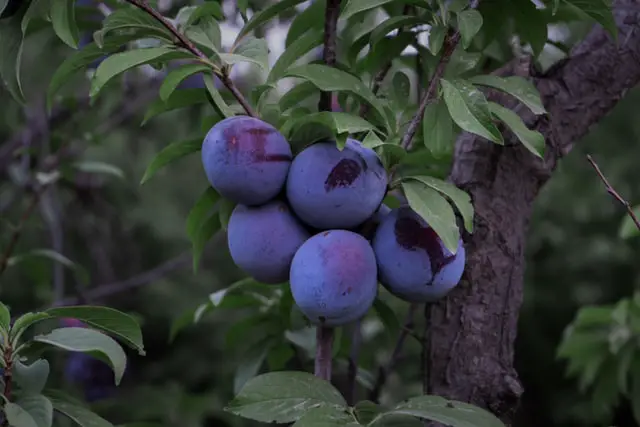Many people will tell you that home grown fruit is far superior in taste to shop bought products. This is absolutely the case for plums too, the flavour you get from growing a patio plum tree is hard to beat.

Plum trees in containers are particularly popular among aspiring gardeners due to their simplicity and success. They stay small too, perfect for even the tiniest of spaces and they won’t get bigger than 1.2 metres.
Whether you ultimately wish to cook your plums into a tasty pudding or indeed want to enjoy fresh from the tree, there is a plum to suit every need.
You can expect heavy crops with patio plum trees, just think of all that fruit jam you can make. Plum fruit can be picked from August and before this, you can enjoy the pretty whites and pinks of the flowering tree.
Jump To...
Best Patio Plum Tree Varieties
When it comes to patio plum tree varieties, you are spoilt for choice. So, we have narrowed down the tedious job of searching and have collated the most popular potted fruit trees with UK gardeners below.
Victoria
Probably the variety of plum that springs to mind the most, Victorias are renowned for their juicy, sweet taste.
They look a treat on the tree too with their crimsons and yellows ready to be enjoyed late summer. This variety is self-fertile too so it really is ideal for modest garden sizes or even the balcony.
- Best Feature: Self-fertile and most well-known plum type
- When To Plant Out: November to March
- Harvest Fruit: Late August
- Best Growing Position: Full Sun and shelter
Opal
Considered a reliable patio fruit tree, Opal plum produces impressive crops of these juicy treats.
They have golden flesh which comes away from the stone with no problems. These can be enjoyed straight from your tree and are attractive trees to grow. Brighten up your current outside space with an opal patio plum tree.
- Best Feature: Heavy cropper
- When To Plant Out: November to March
- Harvest Fruit: Late August
- Best Growing Position: Full Sun
Shropshire
Shropshire plums are a popular cooking plum, however, they can also be enjoyed as a snack straight from the tree.
They have a tart flavour and are a typical plum colour of blues and blacks. They are often used to make damson jam and this tree requires minimal effort.
- Best Feature: Make lovely damson jam
- When To Plant Out: November to March
- Harvest Fruit: September
- Best Growing Position: Full Sun
Growing Plum Trees in Pots – Patio Care Guide
Not a confident gardener but would like to grow fruit anyway? Perhaps the thought of a big tree and its upkeep is a little daunting?
In that case, growing plum trees in pots is the perfect solution for you. Keep reading for our top growing tips.
- What Size Pot for a PlumTree? 24-30” in diameter
- Compost: Well-drained soil
- Watering: Regularly (daily)
- Feeding: A fertiliser and some of your compost heap
- Rootstock: Dwarf rootstock such as Pixy
Common Patio Plum Tree Problems
- Silverleaf: This fungal disease can sadly be fatal for your plum tree and sometimes burning it is the only option to stop it spreading. However, this isn’t always the case and sometimes removing the affected wood is enough to cure it. You shouldn’t assume your plum tree has silverleaf if your leaves have a silver sheen to them. This can be caused by environmental factors – you need to examine the branches. You can help prevent silverleaf by pruning your tree during May and June – any later than this and the risk of infection increases.
- Brown Rot: Affecting the fruit itself, brown rot is a fungal infection that causes affected fruit to turn brown. You might see evidence of fungi spores on the plums and it will, effectively, be rotten and inedible. You need to remove all damaged fruits to prevent brown rot from spreading further.
- Bacterial Canker: Causing damage to the leaves known as Shot hole, bacterial canker can also affect the bark and stems. You will notice parts of the bark are dead and the leaves will have prominent holes in them. To help prevent bacterial canker, avoid pruning except in July or August. Any affected parts of the tree will need removing and you can then apply a wound paint.
Pruning Patio Plum Trees
Pruning patio plum trees is not a hard or time-consuming task so it should not seem a daunting task to undertake. The most important thing to know about pruning plum trees is when to do it and why this is important.
When to Prune Patio Plum Trees
Aim to prune your patio plum tree in the early summer and at no other time in the year as the risks of diseases increase.
How to Prune Patio Plum Trees
When pruning patio plum trees, the main thing to be vigilant of is any diseased branches or buds. You should also be mindful of not allowing your tree branches to become overcrowded.
FAQ’s
Growing plum trees in containers means that even the smallest of gardens can enjoy these fruit trees. They compliment balconies and patios and need so little care that the rewards far outweigh the little work that is required.
Patio plum trees stay at a respectable height of around 1.2 metres and it can be pruned shorter if you wish.
The best compost for patio plum trees is well-drained soil but other than that, they aren’t too fussy. They will benefit from mulch being added for those all-important extra nutrients.
Your pot size for a patio plum tree should be between 24” and 30” in diameter and have good drainage at the bottom.
